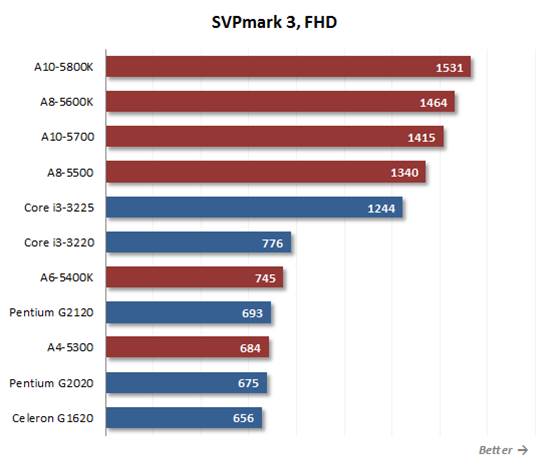The chart shows that AMD's efforts in
promoting the heterogeneous computing concept has not been wasted. The Radeon
HD graphics cores implemented in the Trinity APUs really help improve their
performance. As a result, A10 and A8 APU series are as fast as the Core i3
series, the general perspective differ from what we see in traditional applications
without using graphics core resources. However, the junior dual-core APU
Socket FM2 do not perform as well as their senior relatives. They are still
much slower even than the Celeron G1620.
We should remember that OpenCL does not
make AMD's APU better than their opponents at every point. The GPU-based
acceleration of computations can only be achieved in specific algorithms that
allow decomposing the original task into a lot of identical subtasks. That’s
why the majority of heterogeneous software is still concerned with image and
video processing.
The image editor GIMP is a good example of
such applications. In the latest version, it features a library filters with
enhanced support for OpenCL. Contrary to WinZIP, these filters are almost
exclusively performed on the graphics core whereas the x86 cores only do some
auxiliary work.

OpenCL
does not make AMD's APU better than their opponents at every point
Therefore, there is nothing to wonder that
GIMP runs better on high-performance graphics hardware. To illustrate it, we
can show you the speed of sequential execution of three resource-consuming
effects: Gaussian blur, Motion blur and Bilateral.

GIMP
runs better on high-performance graphics hardware
Enhancing performance based on GPU is what
you can actually pay attention. Under favorable conditions, shader processor
graphics core can guarantee a great performance boost. The graphics core
structure of the AMD's Trinity APU is not only faster than Intel HD Graphics
but also is also more optimized for computing. Hence, the application, such as
GIMP, optimized OpenCL, AMD's APU can provide an outstanding performance when
compared to their Intel peers. The Core i3-3225 with the most advanced version
of Intel’s integrated graphics is only as fast as the junior Socket FM2
processor AMD A4-5300 when it comes to applying these image filters. The other
Intel CPUs are much slower.
Another example of an application that is
compatible with OpenCL is the professional video editing tool Sony Vegas Pro
12. When editing, it can distribute the load between all the computing
resources of the hybrid microprocessors.

An
application which is compatible with OpenCL is the professional video editing
tool Sony Vegas Pro 12
It should be noted that Intel's graphics
core is not compatible with this application for some reason even though Ivy
Bridge is specified to have no limitations in terms of its OpenCL support.
Anyway, the owner of the LGA1155 systems can only rely on the traditional x86
computing resources this time. On the other hand, this fact did not prevent
Intel to looks better in this test rendering in Sony Vegas compared to the
previous case.

Intel's
graphics core is not compatible with Sony
The quad-core Trinity APU of AMD would be
as fast as Intel's Core i3 in Sony Vegas Pro. The dual-core A6 and A4 series
models compete successfully with the Pentium and Celeron CPUs.
Next we test our processors in SVPMark 3.
It is a specialized performance benchmark for the SmoothVideo Project software,
which improved video playback by inserting an intermediate frame in the video
stream. This software makes active use of GPU resources via OpenCL.

Check
our processors in svpmark 3
Graph of APU load show that the x86 core do
the bulk of work here.

Socket
FM2 A10 and A8 from AMD perform better than the Core i3.
However, we still see Socket FM2 A10 and
A8 from AMD perform better than Intel's Core i3. Judging by the difference
between the Core i3-3225 and the Core i3-3220, the graphics core’s performance
is important for this benchmark, so it is no wonder that the quad-core Trinity
models are taking the lead. The dual-core A6 and A4 APUs look good, too.
The results suggest that heterogeneous load
is what the Socket FM2 platform needs to show its best. Intel's CPU, excepting
perhaps the Core i3-3225, are not strong under such conditions. Therefore, if
you plan to use video or image editing applications with OpenCL support, you
may want to consider the performance of the graphics core when selecting the
optimal platform. This factor affects the speed of your platform in such
applications and is even more in 3D games.
We should remember that the integrated
graphics core can only be used for general-purpose computing without discrete
graphics card in the system. If it is installed, integrated graphics disabled
in the processor, so the whole APU concept only applies to integrated
platforms. But when the system includes a discrete graphics core, the
integrated GPU has no effect on 3D or heterogeneous computing performance,
which means that the computing performance of x86 cores remains the main factor
for choosing CPUs for classic discrete PC configurations.